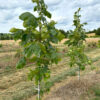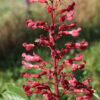Our featured native for June is the American hop-hornbeam, Ostrya virginiana. Ostrya is a small genus in the birch family (Betulaceæ), comprising a handful of species distributed throughout the Northern Hemisphere. It is closely related to the hornbeam or ironwood (Carpinus caroliniana), but is common in xeric conditions, rather than the mesic to hydric habitats favored by Carpinus.
American hop-hornbeam has a native range from southeast Manitoba southward to the Piney Woods of Texas and eastward to the Atlantic, with the exception of the Gulf coast and far southeast coastal plain. There are also isolated populations throughout higher elevations of México and Central America, indicating a much larger range in the past. Its favored habit is drier, rocky uplands. A smaller understory tree, it is typically a relatively slow grower, attaining a mature height of 35 to occasionally 50 feet with a rounded-oval, upright habit. Although naturally adapted to drier sites, it can also thrive in moister situations so long as the soil is well-drained.
[Article continues below photos.]
The leaves are similar to those of Carpinus or birch; ovoid with fine double teeth, tapering to a fine point. Medium-green in color, the autumn color ranges from bright yellow to golden-brown. The bark is greyish-brown to occasionally reddish-grey, with narrow vertical strips ageing to small plates giving a shaggy appearance and winter interest. Male and female flowers in the form of catkins are borne in spring on the same plant. The fruit structure is quite interesting; a 2-inch-long drooping cluster of nutlets enclosed in fleshy bracts. The bracts emerge a very pale whitish-green and mature to a golden-brown and often persist well into winter. The fruiting body strongly resembles brewer’s hops (Humulus lupulus), hence the common name.
The wood of American hop-hornbeam is perhaps the strongest of any native tree. Its smaller size precludes lumber use, but the wood is valuable for tool handles, fenceposts and was used to make longbows by the Lakota people. The tree is host to larvae of several moth and butterfly species. The nutlets are a source of food for small mammals and birds and is a preferred food of the ruffed grouse (Bonasa umbellus).
In the landscape, Ostrya virginiana is a versatile and sadly under-utilized tree. It is adaptable to many conditions, grows slowly to a moderate size, and has an attractive shape, interesting bark, and unique fruit. It works as a specimen or an edge tree and grows well even in the understory of large oaks or pines. Its strong wood withstands winds and ice, and the tree has few significant pests and withstands low moisture levels when established. Like Carpinus, it is very tolerant of shearing and can be used as a hedge.
American hop-hornbeam is a native treasure that deserves a more prominent place in the landscape. White House Natives currently digs Ostrya virginiana in 1½”, 1¾” and 2” caliper. If you are unfamiliar with this tree, give it a try on an upcoming project. You won’t be disappointed!







